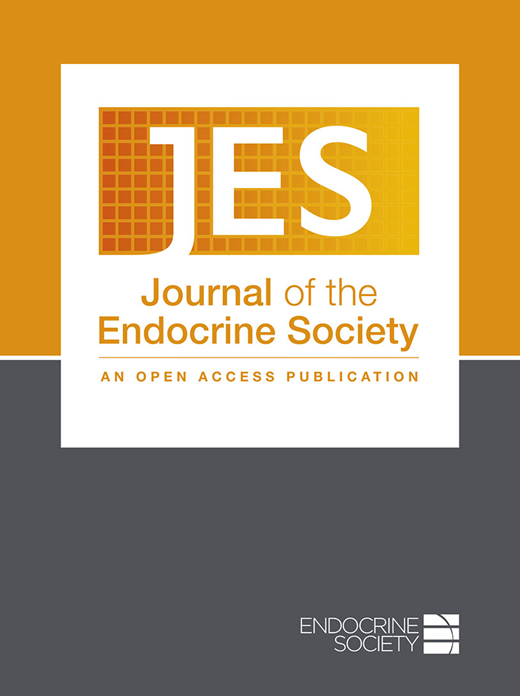The editors from The Journal of the Endocrine Society share their picks for the top endocrine discoveries of 2022.

For Journal of the Endocrine Society editor-in-chief Zeynep Madak-Erdogen, PhD, associate professor of nutrition; Sylvia D. Stroup Scholar at the University of Illinois Urbana-Champaign, “Operation of a TCA Cycle Subnetwork in the Mammalian Nucleus” was a stand-out, published in Science Advances in June by Kafkia, E. et al. “It is fascinating to see how key metabolic pathways are present and functional in the nucleus to change posttranslational modification of key proteins to impact cellular programs,” she says. “There are many implications for how nuclear receptor activities might be directly modulated by metabolic states.”
Madak-Erdogen also appreciated “Gut Bacterial Nutrient Preferences Quantified In Vivo” published in September in Cell by Zeng, X. et al. “This paper is important because they elegantly delineate the nutrient sources for gut microbiota. It makes one reconsider what diet is, how body ecosystem utilizes it, and how one can potentially use diet as a tool to revamp gut microbiota to support health.”
More from Journal of the Endocrine Society Editors

Ana Claudia Latronico, MD, PhD, head professor of the Endocrinology and Metabolism Division of São Paulo University in Brazil, nominates “MC3R Links Nutritional State to Childhood Growth and the Timing of Puberty,” published in Nature in November 2021, by Lam, B. Y. H. et al., for demonstrating a new pathway link between the reproductive and metabolism systems. “It was known that common variants in the vicinity of MC3R (melanocortin receptor type 3) were associated with both adult height and age at menarche,” she explains. “In this study, loss-of-function mutations in MC3R (heterozygous and homozygous) were associated with later onset of puberty in humans. In addition, mice lacking MC3R had delayed sexual maturation and an insensitivity of reproductive cycle length to nutritional perturbation. These findings suggest that MC3R primarily regulates the disposition of calories into growth, lean mass, and the timing of sexual maturation.”
“An Exercise-Inducible Metabolite that Suppresses Feeding and Obesity” by V. L., Li et al., published in Nature in June got a second nod, this one from Stephen R. Hammes, MD, PhD, Louis S. Wolk Distinguished Professor of Medicine; chief, Division of Endocrinology and Metabolism; and executive vice chair, Department of Medicine at the University of Rochester School of Medicine and Dentistry in Rochester, N.Y. “It turns out that Lac-Phe reduces food intake in animals, including mice, humans, and racehorses, without affecting energy expenditure,” he says. “Interestingly this compound is only produced with vigorous aerobic exercise, and may be the reason why, when we exercise hard, our appetite acutely goes down. In animals, administration of Lac-Phe decreases body weight and improves glucose metabolism, whereas reduction of Lac-Phe synthesis in mice increases food intake and obesity following exercise.”
Jodi A. Flaws, PhD, professor, Department of Comparative Biosciences, at the University of Illinois Urbana-Champaign, liked “Correlates of Positive Thyroid Peroxidase Antibodies Among Firefighters: A Cross-Sectional-Study” by Ogunsina, K. et al., published in August in JES. “I was interested in the paper because it is a very novel study on the potential impact of endocrine-disrupting chemicals (EDCs) in flame retardants on thyroid function in firefighters,” she says. “We know that humans are being exposed to EDCs on a daily basis and that firefighters have an increased exposure in flame retardants. However, we have limited information on the impact of such exposures on thyroid function. The paper contains new and important data showing thyroid peroxidase antibodies are high in firefighters, suggesting that we may need to screen/monitor thyroid function in firefighters.”
Roberto Salvatori, MD, professor of medicine and neurosurgery; medical director, Pituitary Center at Johns Hopkins University in Baltimore, Md., chose “Long-term Safety of Growth Hormone in Adults with Growth Hormone Deficiency: Overview of 15 809 GH-Treated Patients” by Johannsson, G. et al. from the June issue of JCEM. “This is the largest cohort of subjects treated with growth hormone (GH) replacement therapy (with the longest follow up) showing that in both adult-onset and childhood-onset GH deficiency, replacement therapy was not associated with increased risks or new cancer or of recurrence of pituitary adenomas,” he says.
Eureka! Part II: What the editors of Endocrinology think are the top endocrine discoveries of 2022.

